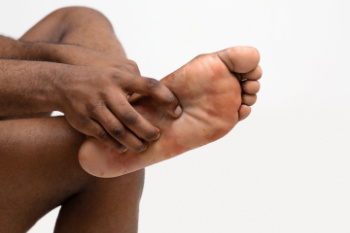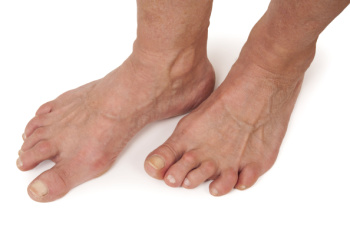
Foot stress fractures are hairline cracks in the bones often caused by repetitive strain. Several risk factors can increase the likelihood of developing stress fractures, especially in the feet. People who participate in high-impact activities, such as running, dancing, or gymnastics, face a higher risk of stress fractures from the repeated pressure and pounding on their feet. Women, particularly those experiencing menstrual irregularities, may be more prone to fractures due to lower bone density. Conditions like osteoporosis or insufficient intake of vitamin D and calcium can further weaken bones and increase the risk. Foot structure issues, such as high arches or flat feet, can also lead to stress fractures, as well as wearing poor footwear or sudden changes in activity surfaces. Podiatrists play a key role in diagnosing and managing foot stress fractures. This foot doctor may use imaging techniques such as MRI scans to confirm the injury. If you have foot pain that may indicate a stress fracture, it is suggested that you schedule an appointment with a podiatrist for an exam and treatment.
Activities where too much pressure is put on the feet can cause stress fractures. To learn more, contact Howard Waxman, DPM from Pleasant Valley Podiatry. Our doctor can provide the care you need to keep your pain free and on your feet.
Dealing with Stress Fractures of the Foot and Ankle
Stress fractures occur in the foot and ankle when muscles in these areas weaken from too much or too little use. The feet and ankles then lose support when walking or running from the impact of the ground. Since there is no protection, the bones receive the full impact of each step. Stress on the feet can cause cracks to form in the bones, thus creating stress fractures.
What Are Stress Fractures?
Stress fractures occur frequently in individuals whose daily activities cause great impact on the feet and ankles. Stress factors are most common among:
Symptoms
Pain from the fractures occur in the area of the fractures and can be constant or intermittent. It will often cause sharp or dull pain with swelling and tenderness. Engaging in any kind of activity which involves high impact will aggravate pain.
If you have any questions please feel free to contact one of our offices located in Willoughby Hills and Broadview Heights, OH . We offer the newest diagnostic and treatment technologies for all your foot and ankle needs.

Pickleball, while a fun and engaging sport, can lead to various foot and ankle injuries due to its fast-paced nature and quick movements. One common injury is an ankle sprain, which often occurs when players twist or land awkwardly during play, resulting in pain and swelling. Another frequent pickleball injury is plantar fasciitis, characterized by heel pain that develops from repetitive stress and strain on the plantar fascia. Achilles tendonitis can also arise from overuse, causing discomfort at the back of the heel. Additionally, blisters and calluses may develop due to friction from quick lateral movements and improper footwear. If you have suffered a foot or ankle injury from playing pickleball, it is suggested that you consult a podiatrist who can treat these conditions and guide you on effective injury prevention techniques.
Ankle and foot injuries are common among athletes and in many sports. They can be caused by several problems and may be potentially serious. If you are feeling pain or think you were injured in a sporting event or when exercising, consult with Howard Waxman, DPM from Pleasant Valley Podiatry. Our doctor will assess your condition and provide you with quality foot and ankle treatment.
Common Injuries
The most common injuries that occur in sporting activities include:
Symptoms
Symptoms vary depending upon the injury and in some cases, there may be no symptoms at all. However, in most cases, some form of symptom is experienced. Pain, aching, burning, bruising, tenderness, tightness or stiffness, sensation loss, difficulty moving, and swelling are the most common symptoms.
Treatment
Just as symptoms vary depending upon the injury, so do treatment options. A common treatment method is known as the RICE method. This method involves rest, applying ice, compression and elevating the afflicted foot or ankle. If the injury appears to be more serious, surgery might be required, such as arthroscopic or reconstructive surgery. Lastly, rehabilitation or therapy might be needed to gain full functionality in the afflicted area. Any discomfort experienced by an athlete must be evaluated by a licensed, reputable medical professional.
If you have any questions, please feel free to contact one of our offices located in Willoughby Hills and Broadview Heights, OH . We offer the newest diagnostic and treatment technologies for all your foot care needs.

Falling outside the home can pose a significant risk, especially for older adults. Falls outside the home can be caused by uneven terrain, slippery surfaces, or crowded areas. Parks, parking lots, and public staircases are common spots where falls may occur, leading to serious injuries like broken bones. Footwear choices play a vital role in preventing falls. Your shoes should offer solid support, fit properly, and have non-slip soles to provide stability. Balance issues, lower extremity weakness, or joint pain can also increase the risk of falls outside the home. A podiatrist can assess these factors, recommend supportive footwear, and suggest custom orthotics to improve balance. This foot doctor can address underlying foot conditions that might compromise your stability or suggest exercises and assistive devices to improve balance. If you have injured your foot or ankle from falling, it is suggested that you schedule an appointment with a podiatrist for appropriate treatment methods.
Preventing falls among the elderly is very important. If you are older and have fallen or fear that you are prone to falling, consult with Howard Waxman, DPM from Pleasant Valley Podiatry. Our doctor will assess your condition and provide you with quality advice and care.
Every 11 seconds, an elderly American is being treated in an emergency room for a fall related injury. Falls are the leading cause of head and hip injuries for those 65 and older. Due to decreases in strength, balance, senses, and lack of awareness, elderly persons are very susceptible to falling. Thankfully, there are a number of things older persons can do to prevent falls.
How to Prevent Falls
Some effective methods that older persons can do to prevent falls include:
Falling can be a traumatic and embarrassing experience for elderly persons; this can make them less willing to leave the house, and less willing to talk to someone about their fears of falling. Doing such things, however, will increase the likelihood of tripping or losing one’s balance. Knowing the causes of falling and how to prevent them is the best way to mitigate the risk of serious injury.
If you have any questions, please feel free to contact one of our offices located in Willoughby Hills and Broadview Heights, OH . We offer the newest diagnostic and treatment technologies for all your foot care needs.

Plantar fasciitis is caused by inflammation of the plantar fascia, a ligament that runs from the heel to the ball of the foot, supporting the arch. The main symptoms of plantar fasciitis is sharp pain in the heel or arch that is often more severe in the morning or after prolonged standing. Heel pain may improve slightly after walking but often returns with continued activity. Risk factors for plantar fasciitis include flat feet, high arches, obesity, and repetitive activities like running. Tight calf muscles can also increase the likelihood of developing this condition. A podiatrist can evaluate your symptoms and recommend treatment options. Included are stretching exercises, footwear adjustments, and custom orthotics. Surgery may be suggested in more severe cases. If you have heel pain caused by plantar fasciitis, it is suggested that you schedule an appointment with a podiatrist for an exam and treatment.
Plantar fasciitis can be very painful and inconvenient. If you are experiencing heel pain or symptoms of plantar fasciitis, contact Howard Waxman, DPM from Pleasant Valley Podiatry. Our doctor can provide the care you need to keep you pain-free and on your feet.
What Is Plantar Fasciitis?
Plantar fasciitis is the inflammation of the thick band of tissue that runs along the bottom of your foot, known as the plantar fascia, and causes mild to severe heel pain.
What Causes Plantar Fasciitis?
How Can It Be Treated?
While very treatable, plantar fasciitis is definitely not something that should be ignored. Especially in severe cases, speaking to your doctor right away is highly recommended to avoid complications and severe heel pain. Your podiatrist can work with you to provide the appropriate treatment options tailored to your condition.
If you have any questions please feel free to contact one of our offices located in Willoughby Hills and Broadview Heights, OH . We offer the newest diagnostic and treatment technologies for all your foot and ankle needs.

Rheumatoid arthritis, or RA, is a chronic inflammatory condition that can significantly impact the feet, leading to a range of symptoms and joint issues. Common signs include pain, swelling, and stiffness in the feet, which often worsen with movement and can limit daily activities. The joints most frequently affected are the metatarsophalangeal joints, located at the base of the toes, as well as the midfoot joints. These areas may become inflamed, causing deformities like bunions or hammertoes. Over time, the inflammation can damage the cartilage and bone, resulting in reduced joint function. Early diagnosis and treatment are vital to managing symptoms and preserving foot mobility. If you have symptoms of RA in the feet, it is suggested that you are under the care of a podiatrist who can help you to manage this condition.
Because RA affects more than just your joints, including the joints in your feet and ankles, it is important to seek early diagnosis from your podiatrist if you feel like the pain in your feet might be caused by RA. For more information, contact Howard Waxman, DPM of Pleasant Valley Podiatry. Our doctor will assist you with all of your podiatric concerns.
What Is Rheumatoid Arthritis?
Rheumatoid Arthritis (RA) is an autoimmune disorder in which the body’s own immune system attacks the membranes surrounding the joints. Inflammation of the lining and eventually the destruction of the joint’s cartilage and bone occur, causing severe pain and immobility.
Rheumatoid Arthritis of the Feet
Although RA usually attacks multiple bones and joints throughout the entire body, almost 90 percent of cases result in pain in the foot or ankle area.
Symptoms
Diagnosis
Quick diagnosis of RA in the feet is important so that the podiatrist can treat the area effectively. Your doctor will ask you about your medical history, occupation, and lifestyle to determine the origin of the condition. Rheumatoid Factor tests help to determine if someone is affected by the disease.
If you have any questions please feel free to contact one of our offices located in Willoughby Hills and Broadview Heights, OH . We offer the newest diagnostic and treatment technologies for all your foot and ankle needs.